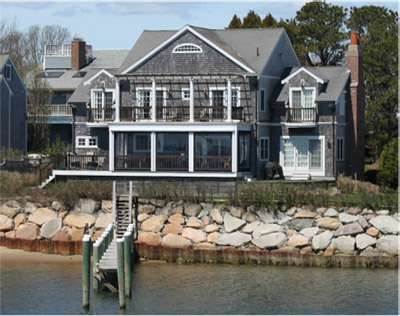 The Federal Emergency Management Agency mapped your house or the house of someone you know into a high-risk flood zone, requiring the you or your friend to pay thousands of dollars in flood insurance rates. What do you do now?
The Federal Emergency Management Agency mapped your house or the house of someone you know into a high-risk flood zone, requiring the you or your friend to pay thousands of dollars in flood insurance rates. What do you do now?
First of all, don’t panic. The U.S. government recently took steps to soften the impact of many of the most drastic proposed changes to flood insurance this year. The Biggert-Waters Reform Act of 2012 eliminated insurance subsidies in high-risk areas and through other measures to make the National Flood Insurance Program (NFIP) self-sustaining.
However, if you received a letter from your mortgage lender indicating the need to purchase or pay higher premiums for flood insurance, you should take it seriously.
Here are few ways to reduce your risk of flood damage and lower your payments.
Learn the terms
Whether you already have flood insurance or are new to the coverage, it helps to know the important terms:
- Base flood elevation (BFE): The elevation at which there is a 1 percent or greater annual chance of flooding. The higher your house’s elevation sits above the BFE for your neighborhood, the lower the flood risk. FEMA uses this elevation to determine your home’s risk.
- Special flood hazard area: If you’re just now finding out that your house is high-risk, your lender probably sent you a notification that it’s in a special flood hazard area. This area is based on the base flood elevation and can determine your flood insurance rates.
Check the map
If you believe there’s been a mistake regarding your house’s placement in a flood zone, take a look at FEMA’s maps. Your insurance company or the online site can provide you with the basic information you need. It will tell you the base flood elevation for your house’s location. Use these maps generally, as they aren’t the official Flood Insurance Risk Maps that FEMA uses to determine risk.
Get a professional opinion
If you intend to challenge your house’s position on the flood map, you must first send a Letter of Map Amendment request to FEMA. After that, you should hire a licensed land surveyor to perform an elevation survey and determine the official risk for your property.
How to reduce the amount you pay
If the challenge fails and your house remains within the boundaries of a high-risk flood zone, purchasing flood insurance is a mandatory requirement for most mortgage holders. There are ways, however, to cut your monthly premiums:
- Purchase a Preferred Risk Policy: Most preliminary maps take 6 to 12 months to take effect, according to the National Flood Insurance Program. FEMA recommends purchasing a Preferred Risk Policy during that time, which can provide coverage at a lower cost. The premium for a Preferred Risk Policy can reach as low as $128 per month, according to FloodSmart.gov. The NFIP recently extended eligibility for Preferred Risk Policies to apply to properties remapped on or after Oct. 8, 2008.
- Grandfather in old rates:
- If you buy a Preferred Risk Policy before the new maps go into effect, you may renew your lower rates for 2 years. In the third year, you potentially can qualify for low-to-moderate risk rates instead of high-risk rates.
- If you already have a flood insurance policy and the base flood elevation has increased in your area, your premiums could increase. Grandfather rules, however, allow you to use the earlier elevation to calculate rates, as long as you’ve maintained continuous flood insurance coverage on the property.
- You also can use grandfather rules if you can prove that your home was built in compliance with the flood map that was in effect at the time of construction, according to FloodSmart.gov.
Enjoy your protection
Your flood insurance rates might increase as a result of remapping, but at least you’ll have coverage if the worst should happen.
Even homeowners in lower-risk areas should consider purchasing protection and could qualify for Preferred Risk Policies. In fact, 20% of flood insurance claims come from moderate-to-low risk areas.
The average flood insurance claim from 2008 to 2012 was nearly $42,000, so purchasing coverage isn’t a bad bet. Even if your lender doesn’t require you to purchase flood insurance, flood protection could save your house from high water and you from taking a financial bath.
For more information on flood insurance in Hingham, MA, contact Lallis & Higgins Insurance.
zillow.com

